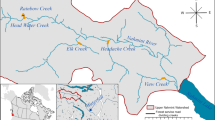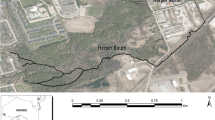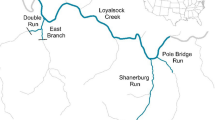Abstract
Native eastern brook trout Salvelinus fontinalis and naturalized brown trout Salmo trutta occur sympatrically in many streams across the brook trout’s native range in the eastern United States. Understanding within- among-species variability in movement, including correlates of movement, has implications for management and conservation. We radio tracked 55 brook trout and 45 brown trout in five streams in a north-central Pennsylvania, USA watershed to quantify the movement of brook trout and brown trout during the fall and early winter to (1) evaluate the late-summer, early winter movement patterns of brook trout and brown trout, (2) determine correlates of movement and if movement patterns varied between brook trout and brown trout, and (3) evaluate genetic diversity of brook trout within and among study streams, and relate findings to telemetry-based observations of movement. Average total movement was greater for brown trout (mean ± SD = 2,924 ± 4,187 m) than for brook trout (mean ± SD = 1,769 ± 2,194 m). Although there was a large amount of among-fish variability in the movement of both species, the majority of movement coincided with the onset of the spawning season, and a threshold effect was detected between stream flow and movement: where movement increased abruptly for both species during positive flow events. Microsatellite analysis of brook trout revealed consistent findings to those found using radio-tracking, indicating a moderate to high degree of gene flow among brook trout populations. Seasonal movement patterns and the potential for relatively large movements of brook and brown trout highlight the importance of considering stream connectivity when restoring and protecting fish populations and their habitats.






Similar content being viewed by others
References
Adams SB, Frissell CA, Rieman BE (2000) Movements of nonnative brook trout in relation to stream channel slope. Trans Am Fish Soc 129(3):623–638. doi:10.1577/1548-8659(2000)129%3C0623:monbti%3E2.3.co;2
Allendorf FW, Phelps SR (1981) Use of allelic frequencies to describe population structure. Can J Fish Aquat Sci 38(12):1507–1514. doi:10.1139/f81-203
Angers B, Bernatchez L, Angers A, Desgroseillers L (1995) Specific microsatellite loci for brook charr reveal strong population subdivision on a microgeographic scale. J Fish Biol 47:177–185. doi:10.1111/j.1095-8649.1995.tb06054.x
Aunins A, Petty KT, Schilz M, Mazik P (2015) River mainstem thermal regimes influence population structuring within an appalachian brook trout population 16(1):15–29. doi:10.1007/s10592-014-0636-6
Ayllón D, Nicola GG, Elvira B, Parra I, Almodóvar A (2013) Thermal carrying capacity for a thermally-sensitive species at the warmest edge of its range. PLoS ONE 8(11):e81,354+. doi:10.1371/journal.pone.0081354
Burrell KH, Isely JJ, Bunnell DB, Van Lear DH, Dolloff CA (2000) Seasonal movement of brown trout in a southern Appalachian river. Trans Am Fish Soc 129(6):1373–1379. doi:10.1577/1548-8659(2000)129%3C1373:smobti.%3E2.0.co;2
Cavalli-Sforza LL, Edwards AW (1967) Phylogenetic analysis. models and estimation procedures. Am J Hum Genet 19(3 Pt 1):233–257. http://www.ncbi.nlm.nih.gov/pmc/articles/PMC1706274/
Chisholm IM, Hubert WA, Wesche TA (1987) Winter stream conditions and use of habitat by brook trout in high-elevation Wyoming streams. Trans Am Fish Soc 116(2):176–184. doi:10.1577/1548-8659(1987)116%3C176:wscauo%3E2.0.co;2
Clapp DF, Clark RD, Diana JS (1990) Range, activity, and habitat of large, free-ranging brown trout in a Michigan stream. Trans Am Fish Soc 119(6):1022–1034. doi:10.1577/1548-8659(1990)119%3C1022:raahol%3E2.3.co;2
Consuegra S, Verspoor E, Knox D, García de Leániz C (2005) Asymmetric gene flow and the evolutionary maintenance of genetic diversity in small, peripheral Atlantic salmon populations. Conserv Genet 6(5):823–842. doi:10.1007/s10592-005-9042-4
Curry Bernatchez L, Whoriskey F, Audet C (2010) The origins and persistence of anadromy in brook charr. Rev Fish Biol Fish 20(4):557–570. doi:10.1007/s11160-010-9160-z
Curry RA, Sparks D, van de Sande J (2002) Spatial and temporal movements of a riverine brook trout population. Trans. Am. Fish. Soc. 131(3):551–560. doi:10.1577/1548-8659(2002)131%3C0551:satmoa%3E2.0.co;2
D’Amelio S, Mucha J, Mackereth R, Wilson CC (2008) Tracking coaster brook trout to their sources: combining telemetry and genetic profiles to determine source populations. N Am J Fish Manag 28(4):1343–1349. doi:10.1577/m05-193.1
Dare MR, Hubert WA, Gerow KG, 2002 Changes in habitat availability and habitat use and movements by two trout species in response to declining discharge in a regulated river during winter. N Am J Fish Manag 22(3):917–928. doi:10.1577/1548-8675(2002)022%3C0917:cihaah%3E2.0.co;2
DeGrandchamp KL, Garvey JE, Colombo RE (2008) Movement and habitat selection by invasive Asian carps in a large river. Trans Am Fish Soc 137(1):45–56. doi:10.1577/t06-116.1
EBTJV (2011) Conserving the Eastern Brook Trout: Action Strategies. Tech. rep., Eastern Brook Trout Joint Venture, 350 Hunkins Pond Road, Sanbornton,NH
Eby LA, Helmy O, Holsinger LM, Young MK (2014) Evidence of climate-induced range contractions in bull trout Salvelinus confluentus in a Rocky Mountain Watershed, U.S.A. PLoS ONE 9(6):e98,812+. doi:10.1371/journal.pone.0098812
Evanno G, Regnaut S, Goudet J (2005) Detecting the number of clusters of individuals using the software STRUCTURE: a simulation study. Mol Ecol 14(8):2611–2620. doi:10.1111/j.1365-294x.2005.02553.x
Fausch KD, White RJ (1981) Competition between brook trout (Salvelinus fontinalis) and brown trout (Salmo trutta) for positions in a Michigan stream. Can J Fish Aquat Sci 38(10):1220–1227. doi:10.1139/f81-164
Fausch KD, Torgersen CE, Baxter CV, Li HW (2002) Landscapes to riverscapes: bridging the gap between research and conservation of stream fishes. BioScience 52(6):483–498. doi:10.1641/0006-3568(2002)052%5B0483:ltrbtg%5D2.0.co;2
Felsenstein J (2002) PHYLIP (Phylogeny Inference Package) version 3.6a3. Distributed by the author. Department of Genome Sciences, University of, Washington, Seattle
Frankham R, Ralls K (1998) Conservation biology: Inbreeding leads to extinction. Nature 392 (6675):441–442. doi:10.1038/33022
Franklin IR (1980) Evolutionary change in small populations, Sinauer Associates, Inc., 23 Plumtree Road, 135–150 http://books.google.com/books/about/Conservation_biology.html?id=YPgTAQAAIAAJ
Garrett JW, Bennett DH (1995) Seasonal movements of adult brown trout relative to temperature in a coolwater reservoir. N Am J Fish Manag 15(2):480–487. doi:10.1577/1548-8675(1995)015%3C0480:smoabt%3E2.3.co;2
Goudet J (2000) FSTAT: A program to estimate and test gene diversities and fixation indices, version 2.9.1
Gowan C, Fausch KD (1996) Mobile brook trout in two high-elevation Colorado streams: reevaluating the concept of restricted movement. Can J Fish Aquat Sci 53(6):1370–1381. doi:10.1139/f96-058
Grant GC, Vondracek B, Sorensen PW (2002) Spawning interactions between sympatric brown and brook trout may contribute to species replacement. Trans Am Fish Soc 131(3):569–576. doi:10.1577/1548-8659(2002)131%3C0569:sibsba%3E2.0.co;2
Hudy M, Coombs JA, Nislow KH, Letcher BH (2010) Dispersal and within-stream spatial population structure of brook trout revealed by pedigree reconstruction analysis. Trans Am Fish Soc 139:1276–1287. http://citeseerx.ist.psu.edu/viewdoc/summary?doi=10.1.1.176.2901
Jones MW, Danzmann RG, Clay D (1997) Genetic relationships among populations of wild resident, and wild and hatchery anadromous brook charr. J Fish Biol 51(1):29–40. http://view.ncbi.nlm.nih.gov/pubmed/9236086
Kanno Y, Vokoun JC, Letcher BH (2011) Fine-scale population structure and riverscape genetics of brook trout (Salvelinus fontinalis) distributed continuously along headwater channel networks. Mol Ecol 20(18):3711–3729. doi:10.1111/j.1365-294x.2011.05210.x
Kanno Y, Letcher BH, Coombs JA, Nislow KH, Whiteley AR (2014) Linking movement and reproductive history of brook trout to assess habitat connectivity in a heterogeneous stream network. Freshw Biol 59(1):142–154. doi:10.1111/fwb.12254
Kelson S, Kapuscinski A, Timmins D, Ardren W (2015) Fine-scale genetic structure of brook trout in a dendritic stream network 16(1):31–42. doi:10.1007/s10592-014-0637-5
King TL, Lubinski BA, Burnham-Curtis MK, Stott W, Morgan RP (2012) Tools for the management and conservation of genetic diversity in brook trout (Salvelinus fontinalis): tri- and tetranucleotide microsatellite markers for the assessment of genetic diversity, phylogeography, and historical demographics 4(3):539–543. doi:10.1007/s12686-012-9603-z
Letcher BH, Nislow KH, Coombs JA, O’Donnell MJ, Dubreuil TL (2007) Population response to habitat fragmentation in a stream-dwelling brook trout population. PLoS ONE 2(11):e1139+. doi:10.1371/journal.pone.0001139
Lewis P, Zaykin D (2002) Genetic data analysis (GDA): computer program for the analysis of allelic data, version 1.1 http://www.eeb.uconn.edu/people/plewis/software.php
Malmqvist B, Rundle S (2002) Threats to the running water ecosystems of the world. Environmental Conservation null:134–153. doi:10.1017/s0376892902000097
Mills LS, Allendorf FW (1996) The one-migrant-per-generation rule in conservation and management. Conserv Biol 10(6):1509–1518. doi:10.1046/j.1523-1739.1996.10061509.x
Mollenhauer R, Wagner T, Kepler MV, Sweka JA (2013) Fall and early winter movement and habitat use of wild brook trout. Trans Am Fish Soc 142(5):1167–1178. doi:10.1080/00028487.2013.793611
Page RDM (2001) TreeView version 1.6.6. University of Glasgow Glasgow. Taxonomy.zoology.gla.ac.uk/rod/treeview.html
Peakall R, Smouse PE (2006) Genalex 6: genetic analysis in Excel. Population genetic software for teaching and research. Mol Ecol Notes 6(1):288–295. doi:10.1111/j.1471-8286.2005.01155.x
Petty JT, Lamothe PJ, Mazik PM (2005) Spatial and seasonal dynamics of brook trout populations inhabiting a Central Appalachian watershed. Trans Am Fish Soc 134(3):572–587. doi:10.1577/t03-229.1
Petty JT, Hansbarger JL, Huntsman BM, Mazik PM (2012) Brook trout movement in response to temperature, flow, and thermal refugia within a complex appalachian riverscape. Trans Am Fish Soc 141(4):1060–1073. doi:10.1080/00028487.2012.681102
Piry S, Alapetite A, Cornuet JM, Paetkau D, Baudouin L, Estoup A (2004) A software for genetic assignment and first-generation migrant detection. J Hered 95:536–539
Plummer M (2013) Rjags: Bayesian graphical models using MCMC
Pritchard JK, Wen X, Falush D (2010) Documentation for structure software: Version 2.3
Core Team (2013) R: a language and environment for statistical computing. R Foundation for Statistical Computing, Vienna, Austria
Rice WR (1989) Analyzing tables of statistical tests. Evolution 43(1):223–225
Roghair CN, Dolloff CA (2005) Brook trout movement during and after recolonization of a naturally defaunated stream reach. N Am J Fish Manag 25(3):777–784. doi:10.1577/m04-034.1
Ross MJ, Kleiner CF (1982) Shielded-needle technique for surgically implanting radio-frequency transmitters in fish. The Progressive Fish-Culturist 44 (1):41–43. doi:10.1577/1548-8659(1982)44%5B41:stfsir%5D2.0.co;2
Sgrò CM, Lowe AJ, Hoffmann AA (2011) Building evolutionary resilience for conserving biodiversity under climate change. Evol Appl 4(2):326–337. doi:10.1111/j.1752-4571.2010.00157.x
Sønstebø JH, Borgstrøm R, Heun M (2007) Genetic structure of brown trout (Salmo trutta L.) from the Hardangervidda mountain plateau (Norway) analyzed by microsatellite DNA: a basis for conservation guidelines. Conserv Genet 8(1):33–44. doi:10.1007/s10592-006-9145-6
Spruell P, Rieman BE, Knudsen KL, Utter FM, Allendorf FW (1999) Genetic population structure within streams: microsatellite analysis of bull trout populations. Ecol Freshw Fish 8(3):114–121. doi:10.1111/j.1600-0633.1999.tb00063.x
Steiner L (2000) Pennsylvania Fishes, Pennsylvania Fish and Boat Commission, P.O.Box 6700
Stranko SA, Hilderbrand RH, Morgan RP, Staley MW, Becker AJ, Roseberry-Lincoln A, Perry ES, Jacobson PT (2008) Brook trout declines with land cover and temperature changes in Maryland. N Am J Fish Manag 28(4):1223–1232. doi:10.1577/m07-032.1
Wagner T, Deweber JT, Detar J, Sweka JA (2013a) Landscape-scale evaluation of asymmetric interactions between brown trout and brook trout using two-species occupancy models. rans Am Fish Soc 142(2):353–361. doi:10.1080/00028487.2012.734892
Wagner T, Irwin BJ, Bence JR, Hayes DB (2013b) Detecting temporal trends in freshwater fisheries surveys: statistical power and the important linkages between management questions and monitoring Objectives. Fisheries 38(7):309–319. doi:10.1080/03632415.2013.799466
Wang J (2004) Application of the one-migrant-per-generation rule to conservation and management. Conserv Biol 18(2):332–343. doi:10.1111/j.1523-1739.2004.00440.x
Waples RS (2010) Spatial-temporal stratifications in natural populations and how they affect understanding and estimation of effective population size. Mol Ecol Resour 10(5):785–796. http://view.ncbi.nlm.nih.gov/pubmed/21565090
Waples RS, Do C (2008) ldne: a program for estimating effective population size from data on linkage disequilibrium. Mol Ecol Resour 8(4):753–756. doi:10.1111/j.1755-0998.2007.02061.x
Waters TF (1983) Replacement of brook trout by brown trout over 15 Years in a Minnesota stream: production and abundance. Trans Am Fish Soc 112(2A):137–146. doi:10.1577/1548-8659(1983)112%3C137:robtbb%3E2.0.co;2
Whiteley A, Hastings K, Wenburg J, Frissell C, Martin J, Allendorf F (2010) Genetic variation and effective population size in isolated populations of coastal cutthroat trout. Conserv Genet 11(5):1929–1943. doi:10.1007/s10592-010-0083-y
Wilson AJ, Hutchings JA, Ferguson MM (2004) Dispersal in a stream dwelling salmonid: Inferences from tagging and microsatellite studies. Conserv Genet 5(1):25–37. doi:10.1023/b%253acoge.0000014053.97782.79
Wydoski RS, Cooper EL (1966) Maturation and fecundity of brook trout from infertile streams. J Fish Res Bd Can 23(5):623–649. doi:10.1139/f66-055
Young MK (1994) Mobility of brown trout in south-central Wyoming streams. Can J Zool 72(12):2078–2083. doi:10.1139/z94-278
Young RG, Hayes JW, Hay J (2010) Movement and mortality of adult brown trout in the Motupiko River, New Zealand: effects of water temperature, flow, and flooding. Trans Am Fish Soc 139(1):137–146. doi:10.1577/t08-148.1
Acknowledgments
We thank Jason Detar, Dave Kristine, and John Sweka for assisting with field sampling, and Josh Hickey, Evan Faulk, and Zeb Buck for assisting with radio tracking. We also thank Shannon Julian for assistance with genetic analyses and Todd Petty for helpful comments on an earlier draft of this manuscript. Finally, we thank the Pennsylvania District of Conservation and Natural Resources (Steve VanEerden) for allowing access to their property to conduct this research. Funding was provided by the U.S. Geological Survey and the Pennsylvania Fish and Boat Commission. Any use of trade, firm, or product names is for descriptive purposes only and does not imply endorsement by the U.S. Government. The handling of fish followed protocols approved by The Pennsylvania State University Institutional Animal Care and Use Committee (IACUC # 35254). The findings and conclusions in this article are those of the author(s) and not necessary represent the views of the U.S. Fish and Wildlife Service.
Author information
Authors and Affiliations
Corresponding author
Additional information
Disclaimer: This draft manuscript is distributed solely for purposes of scientific peer review. Its content is deliberative and predecisional, so it must not be disclosed or released by reviewers. Because the manuscript has not yet been approved for publication by the US Geological Survey (USGS), it does not represent any official finding or policy.
Electronic supplementary material
Below is the link to the electronic supplementary material.
Rights and permissions
About this article
Cite this article
Davis, L.A., Wagner, T. & Bartron, M.L. Spatial and temporal movement dynamics of brook Salvelinus fontinalis and brown trout Salmo trutta . Environ Biol Fish 98, 2049–2065 (2015). https://doi.org/10.1007/s10641-015-0428-y
Received:
Accepted:
Published:
Issue Date:
DOI: https://doi.org/10.1007/s10641-015-0428-y




